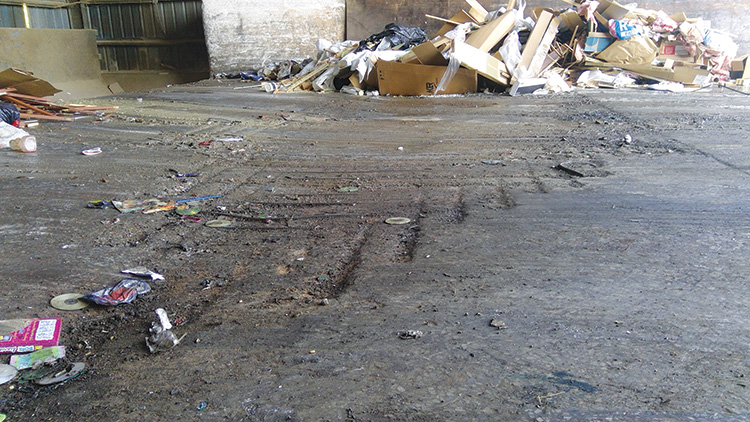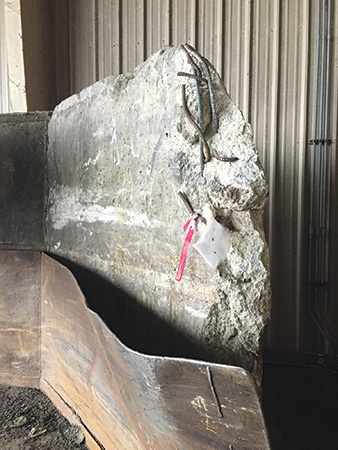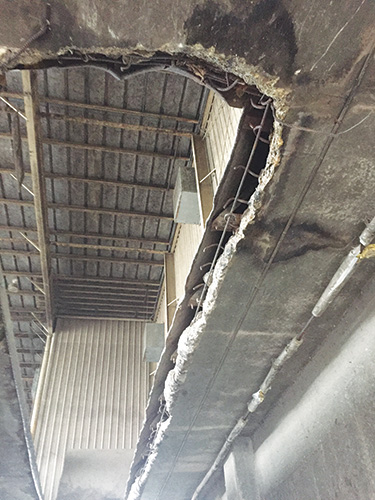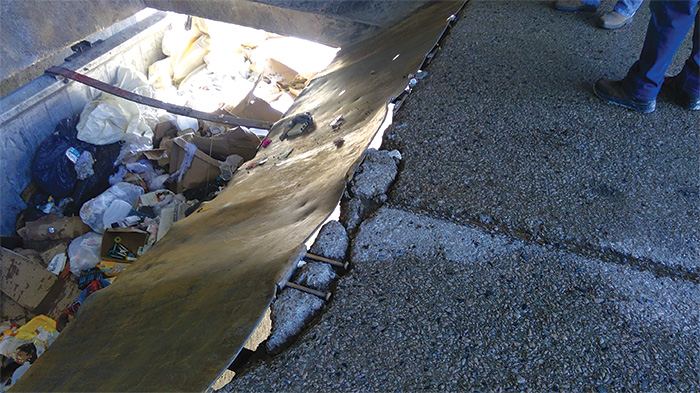Transfer stations remain an expensive type of facility to own and operate due to their harsh exposure. However, with some changes in approach and expectations, the types of self-propagating issues leading to this can be mitigated.
By R. Brett Holland, John Ralph Leak, Matthew R. Sherman, and Buddy Bowers
The difficulty in owning, operating, and maintaining solid waste transfer stations is often underappreciated. At first glance, a transfer station seems like a simple structure, consisting of a metal building, concrete floor, and, most commonly, a pit to load material into trailers. As simple as these facilities may seem, the extremely aggressive exposure environment and continuous operations make them very tricky to keep in operation. Our experience shows that designers and owners both frequently underappreciate the complexity of these facilities during initial design and construction, routine maintenance, and rehabilitation projects.
In today’s environment of operational cost pressures, employee turnover, and constrained budgets, our industry needs to “up our game” and better navigate all the different challenges of our unique facilities—they will wear out, break, and will need repair in the future.
Our Challenge
Transfer stations are inherently subjected to extremely harsh wear and tear that is not anticipated by current building codes, such as:
• Abrasion: Normal operations naturally cause the top surface of the concrete to abrade away due to the near-constant loader traffic using the edge of the bucket to pick up and move solid waste (see Figure 1).
• Leachate: The acidic leachate liquid that is a by-product of handling solid waste attacks the concrete, effectively eating away at the underlying concrete with continued exposure, making the concrete more susceptible to abrasion damage.
• Aggressive Equipment Use: Practices such as operating the loader with the bucket fully down in order to quickly move liquids and solids attached to the floor causes significant abrasion and damage to the floor. Similarly, the push walls and deflector shield systems around the pit and tipping floor are also frequently damaged by direct impact of the buckets against steel plating and push walls that causes damage.
• Maintenance and Cleaning Challenges: Failure to keep up with maintenance and cleaning of the facility accelerates the wear on the tipping floor and can impact the functionality of walls and deflector plate systems.

As a result of their aggressive exposure, transfer station facilities require ongoing maintenance and may only last approximately three to four years before significant repairs are required to the tipping floor, push walls, pit shielding, and building structure.
Facilities often will implement short-term or “quick-fix” style repairs to keep the facility operational in the short term, maintain compliance with environmental containment requirements, and to keep customers happy. While these types of short-term repairs may allow the facility to continue operating, too often we see facilities that operate on patch fixes for extended periods of time. In many cases, these damaged areas can expand from the original footprint of the repair and end up creating much larger issues and significant long-term costs. For example, when sections of steel plating on a push wall become bent or pulled away from the wall, many facilities will simply cut out the section of plating so that it does not damage the loader. However, by doing this and continuing to operate the facility, frequently the concrete behind the wall will become damaged over time, resulting in a need to now repair both the concrete and the steel plating as a larger project (see Figure 2).

When the time for more significant structural repairs arrives, even these repairs may not always perform as intended. We frequently see large-scale repairs implemented that may work for the code prescribed loads and exposures, but that do not address the harsh working conditions present in transfer stations. The design of repairs must consider not only structural loadings, but must also incorporate a fundamental understanding of the unique operational demands faced by transfer stations to prevent the underlying problem from occurring again. For instance, the cantilever edges many facilities have by the pits are designed as either structural steel or reinforced concrete for the weight of the loaders. However, these designs frequently do not account for the damage caused by the buckets on the loaders, both through impact and wear (see Figure 3 and 4). As a result, these edges will wear out faster than anticipated, but not due to the structural loads.
Lastly, the economic landscape is changing, challenging our facility operators. While savvy operators are well aware of features that break down and need periodic repairs and will anticipate this for capital planning purposes, this is becoming more difficult. Due to the aggressive exposure and use of these facilities, estimating costs of future maintenance and repairs differs greatly from most buildings, and labor and material prices for future repairs based on pre-pandemic numbers and budgets are likely no longer valid, making forecasting even harder.


So, What Can We Do?
Facing the challenges presented by our specialized facilities and operations, what can we do to “up our game” as an industry? We propose the following:
• Understand why things fail and incorporate that into the design of structures and repairs to ensure long-term performance. Operational concerns (e.g., smooth edges to not catch loader buckets and easily replaceable shielding plates) control our structures and need to be “built in.”
• Design with lifecycle costs in mind. With transfer stations, the concept of designing something to never fail is often unrealistic or cost prohibitive. A novel concept being used more frequently on these facilities is to accept that the harsh environment will cause the tipping floor to wear out quickly even with costly overlay materials and instead designing lower-cost sacrificial floors that are easy to replace, but have a potentially shorter service life. These types of options can help decrease short-term costs for owners and, when maintained properly, serve for extended periods of time.
• Develop lifecycle thinking for operational and repairs. Short-term fixes are done with the best of intentions or in the interest of immediate need, but can cause significant structural and functional damage over time. Similarly, routine maintenance, such as routine rinsing of the floors, cleaning of floor and area drains to allow for leachate drainage, and taking care to remove debris off the supporting structure without impact and damage all can greatly prolong the useful life of floors. Encouraging equipment operators to be cognizant of their impact on the wear and tear of the facility is paramount. Even the best designed facility can only take so much abuse
• Be aware that patch fixes are exactly that; they are not designed to withstand the test of time and are a short-term measure. Implementing proper budgeting and forecasting for maintenance and repairs to prolong the useful life of the facility pays off in the long run. When routine maintenance and properly executed timely repairs are not performed, the cost of performing a facility-wide renovation to restore its functionality will far exceed the expected budgets of many owners.
• Base capital planning and budgeting on similar structures. Owners and operators need to establish realistic budgets for repairs and include them in capital planning efforts. This includes engaging qualified individuals experienced with these types of facilities to help forecast the types of repairs that will be needed and the associated costs of these repairs, recognizing that the cheapest option likely does not guarantee the same performance of more robust repairs. There is not one single approach to this, so the owner should discuss their goals and objectives to help identify a realistic plan that fits their needs and available budget and stick with it. Additionally, proper contingencies should be carried for the unforeseen issues that will inevitably arise between planned rehabilitation projects.
• Better plan for large-scale repairs. Given the harsh use of these facilities, even well-designed facilities will not last forever and large-scale repairs will be required. Facility owners and operators do not like to hear this and frequently ask the question of “how do we make more durable cost-effective repairs?” The answer to this is not easy and requires getting all parties involved to help change their approach. Designers need to adapt their approach to think beyond just the code requirements for durability and structural capacity. This will be a fundamental shift in the approach taken by many parties and requires engineers to critically think about their designs and listen to the feedback from owners, operators, and contractors on what they have seen work well or fail quickly. This communication stream should work both ways, with engineers helping owners set realistic expectations for their facilities and repair efforts.
Closing Thoughts
Transfer stations remain an expensive type of facility to own and operate due to their harsh exposure. However, with some changes in approach and expectations, the types of self-propagating issues leading to this can be mitigated. These changes require a shift in approach from all parties, including realistic expectations and budgets, consistent cleaning and maintenance of facilities, and proper design and execution of repairs. With these changes, the service life of facilities can be extended, and the longevity and performance of repairs can be improved. | WA
R. Brett Holland is a Senior Project Manager with Simpson Gumpertz & Heger, Inc. of Waltham, MA and is a registered Professional Engineer and Structural Engineer. Brett has more than 15 years of research and industry experience. He specializes in developing and implementing concrete for high-performance applications, concrete placement troubleshooting, specialized durability requirements, and investigating and repairing structures. He has investigated, designed, and rehabilitated a variety of structures, including historic stadiums, mechanically stabilized earth walls, precast concrete, concrete overlays, solid waste transfer facilities, and bridge and port structures. He can be reached at [email protected].
Matthew R. Sherman is a Senior Principal with Simpson Gumpertz & Heger, Inc. and is a registered Professional Engineer and a Fellow of the American Concrete Institute and the International Concrete Repair Institute. Matthew has more than 25 years of experience in consulting and heavy construction throughout the U.S. His specialties include concrete materials, thermal and durability simulation, non-destructive testing, corrosion mitigation, and concrete repair. He can be reached at [email protected].
John Ralph Leak is the President of Leak & Associates, Inc. and a licensed commercial general contractor. John has more than eight years of specialized experience in the construction and rehabilitation of trash transfer facilities. John has been in an active role of estimating, business development, and job site evaluations for Leak & Associates. He can be reached at [email protected].
Buddy Bowers is the lead Superintendent for Leak & Associates, Inc. He has more than 50 years of construction experience as a contractor. Buddy has 25 years of experience with Leak and Associates. During that time he has been instrumental in the development and implementation of design concepts and repairs for waste transfer facilities that have proven more durable than typical designs. He can be reached at [email protected].
